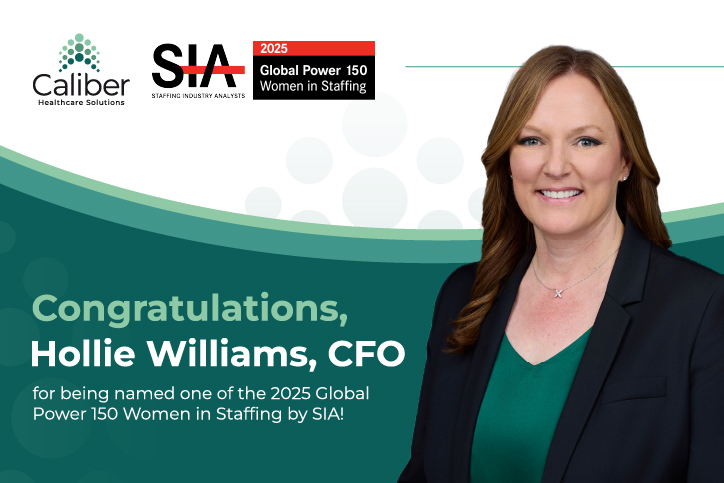.png)
Optimizing your radiology practice's workflow is crucial for delivering excellent patient care and maintaining operational efficiency in today's fast-paced healthcare industry. Enhancing service and staffing quality are essential to address your facility's pain points and boost the productivity of your radiology workforce. Below, we outline four actionable tips, and offer a bonus fifth to effectively mitigate staffing shortages and enhance your radiology department's performance, improve workplace satisfaction, and cultivate operational excellence.
Efficient workflow optimization impacts everything from patient care to resource utilization and overall operational performance. By streamlining processes, eliminating bottlenecks, and fully harnessing human and technological resources, your facility can significantly enhance productivity, reduce wait times, improve diagnostic accuracy, and achieve cost savings. This not only improves your staff's work environment but ultimately leads to better patient outcomes.
Workflow optimization in radiology involves identifying pain points and systematically enhancing operational processes to maximize resource use and boost departmental productivity. It encompasses various strategies, such as task allocation, communication, documentation, equipment utilization, and patient flow management. By identifying areas for improvement and implementing targeted interventions, radiology departments can optimize their workflows and achieve optimal results for both patients and staff.
Inefficient workflows in radiology departments can lead to significant delays in image interpretation and reporting, resulting in prolonged waiting times, delayed treatments, and patient dissatisfaction. These inefficiencies can also increase costs, decrease staff productivity, and heighten stress among Radiologists, technicians, and support staff, negatively affecting morale and overall department performance. Addressing these inefficiencies through continuous improvement is crucial to enhancing patient care, maintaining department efficacy, and preserving the reputation of your radiology practice.
To effectively address your radiology department's pain points, leaders should focus on four areas to not only boost operational efficiency but also foster a positive work environment that paves the way for better patient outcomes.
Clear and timely communication between Radiologists, technologists, nurses, and other healthcare professionals is essential to improve radiology department productivity. Implementing communication systems such as secure messaging platforms, integrated electronic medical record systems, and digital engagement tools can facilitate efficient information exchange, reduce errors, and promote a collaborative work environment.
The integration of advanced technology and software solutions can automate manual tasks, enhance image processing speed, and improve reporting efficiency for your radiology workforce. Implementing picture archiving and communication systems (PACS), radiology information systems (RIS), and artificial intelligence (AI) tools can streamline workflow and improve diagnostic accuracy. These technological tools and AI solutions not only boost productivity but empower Radiologists to deliver more precise diagnoses and can elevate patient education.
Continuous staff training and development are crucial in radiology departments to maintain competency and keep pace with advancements in imaging technology and AI applications. Regular training sessions, coupled with participation in professional development programs and conferences, enhance skills, foster a culture of innovation, support staff, and foster effective radiology workflow optimization.
Efficient patient scheduling and throughput management are vital to improve radiology department productivity. Implementing appointment reminder systems, utilizing time data analytics, and streamlining patient registration and imaging processes, departments can enhance patient flow, reduce delays, and boost overall efficiency. Additionally, strategies like dedicating specific slots for complex procedures and employing flexible staffing models can significantly improve radiology workflow.
Locum tenens Radiologists can significantly enhance efficiency by filling schedule gaps during peak periods or staff shortages, ensuring continuous patient care and department productivity. These temporary healthcare providers not only alleviate radiology workflow bottlenecks but also bring diverse experiences and fresh perspectives that contribute to better clinical outcomes. By seamlessly integrating into teams without the need for lengthy onboarding, locum tenens providers help minimize burnout among permanent staff and sustain departmental productivity, making them a flexible and vital resource in achieving an optimal radiology workforce.
Staffing agencies like Caliber work with radiology practice leaders to address their pain points and identify a strategy to integrate locum tenens providers into their department. With a robust network of talent, we can work with you to effectively manage fluctuating demand and maintain operational continuity. With Caliber’s support, facilities can optimize their staffing strategies, reduce patient waiting times, and enhance overall clinical outcomes, leveraging locum tenens to improve radiology department productivity.
Optimizing your radiology workflow efficiency is an ongoing process that requires continuous monitoring and the willingness to make necessary adjustments. Effective performance tracking and reporting mechanisms are essential for identifying areas of improvement and assessing the impact of changes. Utilizing time data analytics, for example, can offer insights into workflow efficiency, helping radiology leaders make data-driven decisions that enhance productivity and patient care.
Key performance indicators (KPIs) should include metrics on scan times, image quality, report turnaround times, and patient satisfaction. These metrics provide a clear picture of the workflow's strengths and weaknesses, guiding the department in prioritizing areas for improvement. Advanced technology, such as enterprise imaging and artificial intelligence, also plays a crucial role in facilitating accurate and real-time tracking of these KPIs.
Regular radiology workflow audits are essential for identifying inefficiencies and making necessary adjustments in radiology departments. These audits help uncover issues ranging from minor bottlenecks to significant systemic problems, enabling leaders to implement targeted improvements that enhance productivity and patient care. By iteratively refining processes such as staff communication, patient scheduling, and adopting AI solutions for image processing, these changes promote a culture of continuous improvement and innovation, leading to more efficient operations.
Employee feedback is crucial for optimizing workflow within the radiology department, as staff directly involved in daily operations offer insights into pain points and improvement opportunities. Encouraging open dialogue and involving staff in the decision-making process fosters innovation, enhances patient care, boosts morale, and ensures your healthcare team's buy-in.
At Caliber, we recognize the importance of ongoing support as you make radiology workflow improvements. Although AI solutions and technology infrastructure encompass a good portion of your strategy, you need qualified Radiologists who are equipped to augment your team. That's where we come in. Through providing access to locum tenens professionals who are not only skilled in their medical practice but also in utilizing advanced radiology systems, Caliber ensures that your radiology workforce is equipped to deliver precise diagnoses and improved clinical outcomes.
At Caliber, our specialty-focused teams stand at the forefront of addressing the multifaceted challenges faced by radiology departments today. Through our customized staffing solutions and provider-centric approach, we cater our approach to the unique needs of each facility.
Our commitment to equipping practices with high-caliber locum tenens professionals ensures that our radiology clients can enhance their department's workflow and achieve operational goals. We dedicate ourselves to facilitating seamless integration of locum tenens into radiology teams, providing ongoing support and enhancing patient satisfaction.
For expert assistance in navigating the complexities of staffing and operational efficiency at your radiology practice, contact Caliber Healthcare Solutions. Let’s partner together to build a more successful department.

Posted on
October 9, 2025
Caliber is proud to announce that our Chief Financial Officer, Hollie Williams, has been named to the Staffing Industry Analysts (SIA) 2025 Global Power 150 Women in Staffing list. This prestigious recognition honors women who are shaping the future of the staffing industry through innovation, leadership, and measurable impact.

Posted on
August 14, 2025
The OB/GYN workforce is at a pivotal moment. Demand is growing, especially in underserved regions. Meanwhile, retirements, burnout, and legislative pressure continue to shrink the supply of practicing physicians.

Posted on
August 10, 2025
The U.S. is experiencing a growing OB/GYN shortage that’s reshaping access to care for millions of women. In rural and urban communities alike, hospitals are closing labor and delivery units.

Posted on
October 9, 2025
Caliber is proud to announce that our Chief Financial Officer, Hollie Williams, has been named to the Staffing Industry Analysts (SIA) 2025 Global Power 150 Women in Staffing list. This prestigious recognition honors women who are shaping the future of the staffing industry through innovation, leadership, and measurable impact.

Posted on
October 2, 2025
We are proud to announce Allie Taylor, Corporate Counsel at Caliber Healthcare Solutions, has been recognized as a finalist for D CEO’s 2025 Corporate Counsel Award. Now in its 16th year, this prestigious program honors the top in-house attorneys across North Texas—an achievement that speaks volumes about Allie’s remarkable impact in the legal field.

Posted on
August 10, 2025
At Caliber, we believe Locum Tenens Week should be more than a weeklong celebration; it should be a spotlight on the long-term difference providers make every day. As a provider-centric organization, we know that when physicians and APPs are supported, their impact doesn’t just fill a gap, it transforms care for entire communities.This year’s NALTO theme, “Temporary Providers, Permanent Impact,” resonates deeply with us. Because while locum assignments are sometimes measured in weeks or months, the care delivered, and the trust built can span years and touch thousands of lives.
.png)
Posted on
May 9, 2024
The need for Radiologists is increasing, driven by an aging population that typically requires more medical imaging. According to the World Health Organization, the proportion of the world's population aged 60 and older is set to nearly double from 12% to 22% between 2015 and 2050.
.png)
Posted on
May 7, 2024
As a Radiologist, you're at the forefront of medical imaging and diagnostics. With the growing demand for Radiologists, your skills are more valuable than ever, opening doors to varied and exciting career paths.
.png)
Posted on
May 1, 2024
How much does a Radiologist make? Well, it depends. Salaries for Radiologists can vary widely across similar jobs, influenced by elements such as location quotients, years of experience, and sub-specialization.

Posted on
August 14, 2025
The OB/GYN workforce is at a pivotal moment. Demand is growing, especially in underserved regions. Meanwhile, retirements, burnout, and legislative pressure continue to shrink the supply of practicing physicians.

Posted on
August 12, 2025
Physicians in 2025 are facing rising workloads, shifting care team structures, and evolving career expectations. See the 4 biggest trends shaping the profession—and how locum tenens offers flexibility, balance, and control.

Posted on
August 12, 2025
For OB/GYNs, compensation is only one part of a complex equation that includes work-life balance, autonomy, and the ability to practice medicine on your own terms.